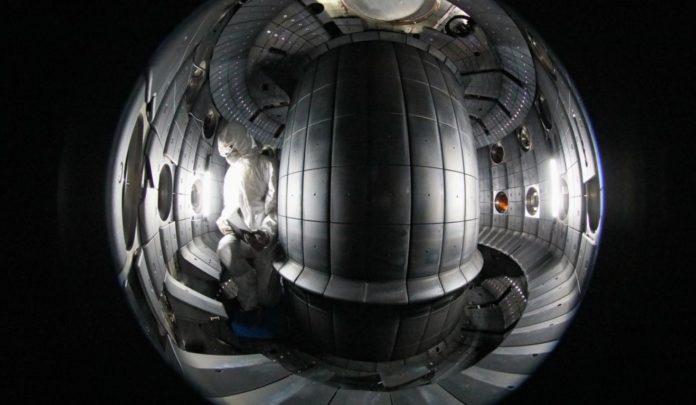Fusion is a promising way to get energy in the future. It involves the merger of two atomic nuclei, releasing massive amounts of energy. The Sun’s warmth originates from hydrogen nuclei fusing into heavier helium atoms, which we see every day.
ITER is an international fusion research megaproject that attempts to recreate the Sun’s fusion processes in order to generate energy on Earth. Its goal is to create a high-temperature plasma environment that allows fusion to occur and produce energy.
Plasmas, which resemble gases in that they are made up of positively charged nuclei and negatively charged electrons, are almost a million times less dense than the air we breathe. Plasmas are formed by heating hydrogen atoms to extremely high temperatures (10 times that of the Sun’s core), pushing electrons to split from their atomic nuclei. The process takes place inside a “tokamak,” which is a donut-shaped (“toroidal”) structure.
“In order to create plasma for fusion, you have to consider three things: high temperature, high density of hydrogen fuel, and good confinement,” explains Paolo Ricci.
Ricci’s team, working as part of a large European collaboration, has now published a study that updates a fundamental principle of plasma generation, demonstrating that the upcoming ITER tokamak can operate with twice the amount of hydrogen and thus generate more fusion energy than previously thought.
“One of the limitations in making plasma inside a tokamak is the amount of hydrogen fuel you can inject into it,” adds Ricci. “Since the early days of fusion, we’ve known that if you try to increase the fuel density, at some point there would be what we call a ‘disruption’ – basically you totally lose the confinement, and plasma goes wherever. So in the eighties, people were trying to come up with some kind of law that could predict the maximum density of hydrogen that you can put inside a tokamak .”
Martin Greenwald, a fusion scientist, proposed a renowned formula in 1988 that connects fuel density to the tokamak’s minor radius (the radius of the donut’s inner circle) and the current flowing in the plasma inside the tokamak. The “Greenwald limit” has been a core notion of fusion research ever since; in fact, it is the basis for ITER’s tokamak-building technique.
“Greenwald derived the law empirically, that is completely from experimental data – not a tested theory, or what we’d call ‘first principles’,” Ricci adds. Still, the limit worked pretty well for research. And, in some cases, like DEMO (ITER’s successor), this equation constitutes a big limit to their operation because it says that you cannot increase fuel density above a certain level.”
The Swiss Plasma Center, in collaboration with other tokamak teams, devised an experiment in which very sophisticated equipment was used to precisely manage the amount of fuel fed into a tokamak. The major tests took place in the Joint European Torus (JET) in the United Kingdom, as well as the ASDEX Upgrade in Germany (Max Plank Institute) and EPFL’s own TCV tokamak. The EUROfusion Consortium, a European organization that coordinates fusion research in Europe, made this big experimental effort possible, and EPFL currently participates in it through the Max Planck Institute for Plasma Physics in Germany.
Maurizio Giacomin, a PhD student in Ricci’s group, began analyzing the physics processes that restrict density in tokamaks at the same time, in order to construct a first-principles law that can correlate fuel density with tokamak size. However, part of that entailed using a computer model to perform advanced plasma simulations.
“The simulations exploit some of the largest computers in the world,” says Ricci, citing CSCS, the Swiss National Supercomputing Center, and EUROfusion. “And what we found, through our simulations, was that as you add more fuel into the plasma, parts of it move from the outer cold layer of the tokamak, the boundary, back into its core, because the plasma becomes more turbulent. Then, unlike an electrical copper wire, which becomes more resistant when heated, plasmas become more resistant when they cool down. So, the more fuel you put into it at the same temperature, the more parts of it cool down – and the more difficult is for current to flow in the plasma, possibly leading to a disruption .”
Simulating this was difficult. “Turbulence in a fluid is actually the most important open issue in classical physics,” argues Ricci. “But turbulence in a plasma is even more complicated because you also have electromagnetic fields.”
Finally, Ricci and his colleagues cracked the code and put “pen to paper” to derive a new equation for the tokamak fuel limit that closely matches experiments. It was published in Physical Review Letters and does credit to Greenwald’s limit by being near to it while significantly updating it.
According to the new equation, the Greenwald limit in terms of fuel in ITER can be nearly doubled, implying that tokamaks like ITER can build plasmas with nearly twice the quantity of fuel without causing disruptions. “This is important because it shows that the density that you can achieve in a tokamak increases with the power you need to run it,” explains Ricci. Actually, DEMO will operate at a much higher power than present tokamaks and ITER, which means that you can add more fuel density without limiting the output, in contrast to the Greenwald law. And that is very good news.”
Image Credit: Getty
You were reading: A New Twist on Fusion Power Could Finally Harness Limitless Star Power
